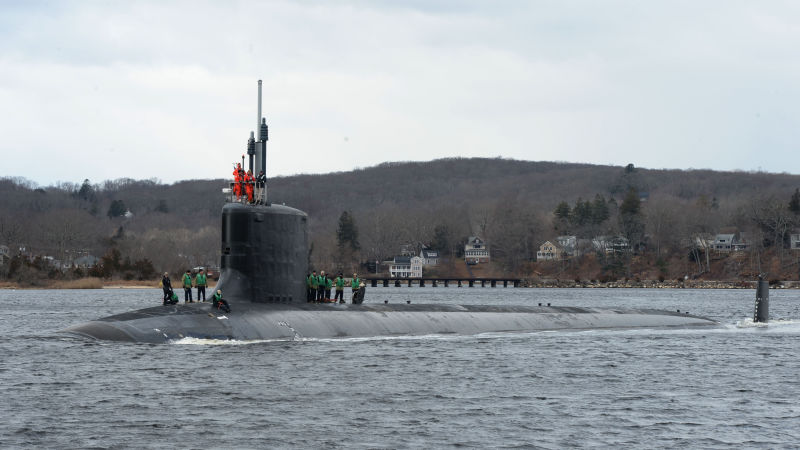
 Foxtrot AlphaTech and news from the world of modern defense.
Foxtrot AlphaTech and news from the world of modern defense.The Navy’s next tranche of attack submarines will control unmanned undersea vehicles and deploy SEAL commandos, according to U.S. Naval Institute News. The shift reflects the Navy’s broad shift towards big power warfare – think a low-grade war with China or Russia – where unmanned submarines would stalk enemy ships and SEAL commandos may need stealthy rides to carry out missions against defended coastlines.
(Of course, there’s the whole notion that a “low-grade war” with China or Russia would never happen in a million years and that sort of thing would pretty much immediately go nuclear, but you know what? Shrug. Just…. shrug. This is what the U.S. government wants to spend its money on. Write your representative.)
The U.S. Navy’s most current submarine class is the Virginia-class nuclear attack submarine. First introduced in 2004, the Virginias are a true post-Cold War design. U.S. submarines produced during the 46 year rivalry with the Soviet Union favored the ability to kill bigenemy ships and submarines—including under arctic ice and deep underwater if necessary. The Virginias, on the other hand, are less expensive jack-of-all-trades boats, designed to perform a wider spectrum of roles against a broader set of enemies, from North Korea to Russia. The U.S. Navy currently operates 17 Virginia-class submarines, and may build as many as 66 of the boats over a period of three or more decades.
Virginia-class submarines are 377 feet long, 34 feet wide, and displace 7,800 tons underwater, which makes them a fair bit smaller than the doomsday submarines, ready to launch nuclear-tipped ballistic missiles at a moment’s notice. They are operated by a crew of 113, and are powered by one General Electric SG9 nuclear reactor to a speed of somewhere over 25 knots (the exact top speed is classified, but subs usually move quite a bit slower anyways due to noise concerns). In addition to anti-surface ship and anti-submarine warfare duties, the ships are also meant to perform intelligence collection missions and strike land targets with Tomahawk land attack cruise missiles.
One submarine, the USS John Warner, participated in the 2018 air and missile strikes against the Syrian government’s chemical weapons stockpiles and other facilities. Here’s periscope video from the John Warner as it launched six Tomahawk cruise missiles against Syrian targets:
The U.S. Navy buys these submarines in so-called “Blocks,” each of which introduces some new technological innovation or cost-saving measure to build upon the previous Block. Block II, for example, introduced new manufacturing techniques, while Block III introduced a new sonar and launch tubes for Tomahawk missiles. This is also leading to a big boost in firepower, as Block I boats are equipped with four torpedo tubes and 12 Tomahawk missiles, while Block V boats will be equipped with four torpedo tubes and 40 Tomahawk missiles.
Advertisement
The Block V boats should, then, be reasonably capable of taking out the entirety of a small seaside town and all its lobster boats on its own, should its captain be so inclined.
The service is now trying to figure out what new features will define Block VI. This requirement is also coming at a time when the Navy is shifting away from supporting land conflicts in Iraq, Afghanistan and elsewhere towards the prospect of going toe-to-toe with Russia or China.

Advertisement
Block VI will be defined by increased support for naval special forces (read: SEALs) and unmanned undersea vehicles, according to USNI News. Navy SEALs, in addition to their role hunting terrorists in mountains and the desert, also do sneaky things like plant limpet mines against enemy ships, man torpedo-toting mini-submarines such as the U.S. Navy’s Mark IX Seal Delivery Vehicle, and conduct raids against enemy coastal facilities. These sorts of things are not really useful chasing down ISIS in Syria or the Taliban in land-locked Afghanistan but could be used, for example, against the Chinese Northern Fleet based in Qingdao or Russian naval facilities in Kaliningrad.

Another mission for Block VI would be supporting unmanned undersea vehicles. The Block VI subs will have the ability to deploy torpedo-sized UUVs through their Virginia Payload Modules, each of which can carry seven Tomahawk missiles or the same volume in drones. Alternately, a Virginia could carry a larger drone, such as the Orca-class extra-large unmanned undersea vehicle (UUV) behind its sail, releasing it to operate autonomously as the subs near the battlefield. The U.S. Navy is ordering four 51-foot long Orca XLUUVs in 2019 for $43 million, with more undoubtedly coming in future years.
Advertisement

UUVs would be very useful in slugfest between major powers. A UUV could mimic friendly submarines, acting as the bait in a trap laid by the Virginia boat to draw out enemy submarines. They could also carry weapons of their own, allowing a single submarine to execute an attack from multiple directions or against multiple enemies. They could collect intelligence, sow minefields, act as a communications node between submarines and other platforms, and even shoot down anti-submarine helicopters and other aircraft menacing the mother submarine. Submarines are dangerous even when weighing their own survival—we barely conceive what a submersible without a crew could accomplish.
The Virginia-class subs were conceived in an era of fiscal austerity in a time when submarines were not exactly needed. The result is an inexpensive (for a nuclear submarine, anyway) multi-purpose platform capable of adapting to the mission set du jour—whether that is destroying chemical weapons caches hundreds of miles inland or battling the best the Chinese Navy has to offer. Now, the sub class will pivot to supporting SEALs and unmanned subs, all without losing existing capabilities. In a Pentagon—and a Navy—full of expensive or poorly conceived ideas, the Virginia-class boats stand out as a success story.













